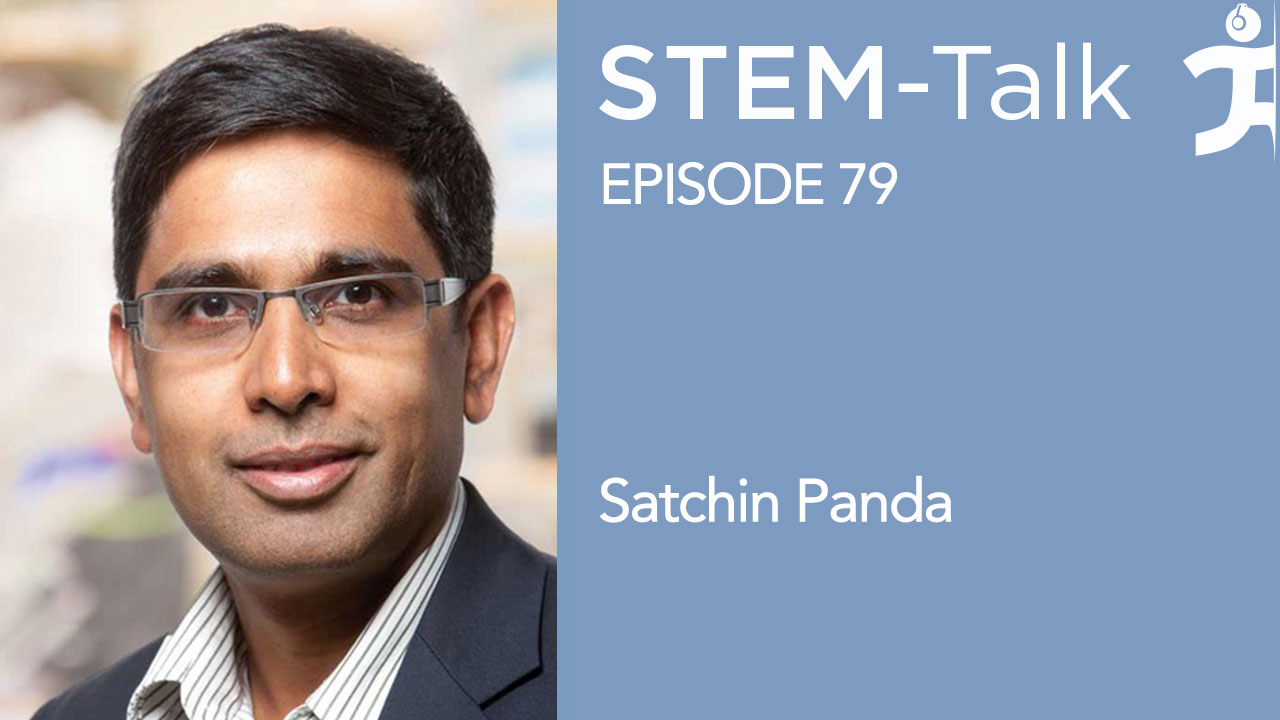STEM-Talk
Episode 79: Satchin Panda discusses circadian rhythms and time-restricted eating to improve health and even reverse disease
// Dec 18, 2018

Dr. Satchin Panda is a professor and researcher at the Salk Institute who has become recognized as one of the world’s leading experts on circadian rhythm. In today’s wide-ranging interview, he discusses how the body’s natural day-night cycle can help us improve our health, get a better night’s sleep and lose weight. He also shares how adopting a lifestyle that is aligned with the body’s natural internal clock can even help us prevent and reverse disease.
Satchin also has been generating significant attention for his research into the health benefits of time-restricted eating. He is the author of “The Circadian Code” and in today’s interview he shares how listeners can become involved in a research project he and his colleagues are conducting through a smartphone app called My Circadian Clock.
In addition to his work at the Salk Institute, Satchin is also a founding executive member of the Center for Circadian Biology at the University of California, San Diego. Key topics covered in today’s interview include:
- [00:03:46] How a rapidly evolving modern society disrupts the interconnectedness of our biological rhythms.
- [00:13:41] How Satchin became interested in circadian rhythms and metabolism.
- [00:17:11] Satchin’s first mouse study on time-restricting feeding, which so surprised him that he ended up repeating the study three times.
- [00:21:37] The role of ketosis in time-restricted eating, particularly in regard to weight loss and potential health benefits.
- [00:25:01] Whether having black coffee signals the beginning of a person’s eating window.
- [00:27:31] The potential use of caffeine to treat jet lag induced by international time-zone travel.
- [00:29:31] Satchin’s mouse studies that looked at obesity and type-2 diabetes.
- [00:30:58] The dangers of shift work and the importance of sleep.
- [00:45:39] Satchin talks about the importance of darkness when it comes to sleep and our circadian rhythms.
- [00:48:42] Satchin’s 2017 paper in Aging Research Reviews titled “ Circadian rhythms, time-restricted feeding, and healthy aging.“
- [00:51:59] Satchin’s recent paper in Cell Metabolism, “Time-Restricted Feeding Prevents Obesity and Metabolic Syndrome in Mice Lacking a Circadian Clock.”
- [01:00:19] The role of diet in people who lost weight during time-restricted feeding.
- [01:06:30] “My Circadian Clock,”an app Satchin and his lab at Salk Institute have developed.
- [01:20:02] Satchin discusses how he convinced his mother to try time-restricted eating.
- [01:25:32] What Satchin’s diet and eating window looks like on a typical day.
Show notes:
[00:03:05] Satchin begins the interview talking about being raised in India and his parents’ expectation that he would become a doctor or engineer. [00:03:46] Satchin talks about his book “The Circadian Code,” which is dedicated to his maternal and paternal grandparents. He touches on how a rapidly evolving modern society disrupts the interconnectedness of our biological rhythms. [00:06:14] Satchin shares how when he was a junior in high school, he lost his father in an accident with a truck driver. [00:07:21] Dawn asks Satchin to talk about how going to agricultural school like his father did cemented Satchin’s interest in science. [00:08:44] Dawn asks how Satchin ended up with a research job at a flavor and fragrance manufacturer in India after finishing his master’s degree. [00:10:10] Satchin talks about what led him to Canada and eventually the U.S. [00:11:21] Ken asks Satchin why he decided to pursue at Ph.D. in plant circadian rhythm. [00:13:41] The circadian rhythm field primarily focuses on understanding the timing mechanism in biological systems like plants, fruit flies, mice and humans. Satchin discusses how he took a different route and became interested in circadian rhythms and metabolism. [00:15:13] Dawn asks what it is like to work at the Salk institute, a place where Nobel laureates such as Francis Crick once worked. [00:17:11] Satchin talks about his first time-restricted feeding mouse study, which so surprised him that he repeated the study three times. [00:19:03] Ken asks Satchin what he was expecting to learn when he started the mouse studies. [00:20:06] Dawn asks about Satchin’s published findings of his experiments in 2012, which raised the question of whether eight hours was the magic number for time-restricted eating. [00:21:37] Knowing that people go into ketosis after 12 to 16 hours without food, Dawn asks if Satchin has looked at the role of ketosis in time-restricted eating, particularly in regard to weight loss and potential health benefits. [00:22:39] In the mouse studies, the mice that followed time-restricted eating also had an endurance benefit. Dawn asks if Satchin thinks this might also be related to ketosis. [00:25:01] Satchin says in his book, “The moment you eat breakfast, or have your first cup of coffee or tea, is the beginning of your eating window.” Dawn points out that Satchin also says in the book that water doesn’t signal the start of the eating window. She then asks about black coffee, which, like water, has no calories. [00:27:31] Ken asks about the potential use of caffeine to treat jet lag induced by international time-zone travel. [00:29:31] Satchin talks about mouse studies his lab did a few years ago that looked at obesity and type-2 diabetes. [00:30:58] Satchin discusses the point he makes in his book about the dangers of shift work and the importance of sleep. [00:35:11] Dawn asks about a study Satchin is currently undertaking looking at firefighters and shift work. [00:38:10] Numerous studies have shown that time restricted feeding schedules may be able to shift the phase of activity in animals such as mice. Ken asks what Satchin thinks the underlying mechanisms of this may be. [00:40:56] In his book, Satchin mentions that chronotypes — the existence of night owls and morning larks — are largely a myth. Ken asks if we really know whether chronotypes exist or not. [00:44:14] Satchin talks about how he responded when, while at a symposium in Stockholm, a well-respected scientist in the area of obesity came up to Satchin after his talk and said there was no data that shift work causes more disease. [00:45:39] Satchin talks about the importance of darkness when it comes to sleep and our circadian rhythm. [00:48:42] Satchin’s 2017 paper in Aging Research Reviews titled “ Circadian rhythms, time-restricted feeding, and healthy aging.“ points out that circadian rhythms optimize physiology and health by temporally coordinating cellular function, tissue function and behavior. Dawn asks how this study found that optimizing the timing of external cues with defined eating patterns could sustain a person’s circadian clock and possibly prevent disease. [00:51:59] Satchin discusses his mouse study that was detailed in his recent paper in Cell Metabolism titled, “Time-Restricted Feeding Prevents Obesity and Metabolic Syndrome in Mice Lacking a Circadian Clock.” [00:54:59] Ken asks if the benefits of time-restricted feeding reproduced in different mouse strains and across genders, or if all studies been done on the same mouse strain/gender. [00:56:43] Dawn asks if the experimental models using mice, who are nocturnal animals, are presenting difficulties in terms of translating the effects of time-restricted feeding on humans. [00:58:39] Ken asks Satchin for his thoughts on the findings of Joseph Takahashi’s work. Ken wonders if Takahashi’s findings imply that some of the benefits of caloric restriction in mice may actually be due to time restriction. [01:00:19] In Satchin’s human studies, people who had 8- to 12-hour eating windows also had some health benefits and lost weight. Dawn asks what role a person’s diet played in weight loss. [01:03:03] Satchin discusses his thoughts on the translatability of research examining circadian rhythm and inflammatory mechanisms in mice. [01:06:30] Satchin and his lab at Salk Institute have developed an app called “My Circadian Clock,” which is part of a research project that’s using smartphones to track people’s daily behaviors. Dawn asks Satchin to give an overview of the project and discuss how people can participate in the research. [01:09:53] Satchin briefly talks about any potential efficacy in commercial sleep tracking devices. [01:12:08] Satchin talks about the findings of a National Institute of Aging paper that showed time-restricted eating might increase longevity. [01:14:40] Satchin talks about his work with Dr. Valter Longo, who was the guest on episode 64 of STEM-Talk. [01:16:45] While research on chronopharmacology is encouraging, Satchin discusses what some of the main logistical constraints we face in trying to apply its tenets in the clinic. [01:20:02] Satchin discusses how he convinced his mother to try time-restricted eating. [01:23:01] Commenting on how all of Satchin’s mother’s siblings have some sort of metabolic disease, either high cholesterol, diabetes, hypertension or a combination of the three, Dawn asks what is it about the Indian diet that is so unhealthy. [01:25:32] Satchin talks about what his diet and eating window look like on a typical day. [01:26:28] Regarding the symposium Satchin attended in Stockholm. Ken asks how he deals with travel and jet lag in terms of his circadian rhythm. [01:28:27] In terms of the future, Dawn ends the interview asking Satchin what new studies he is considering and what direction he thinks his research will take.Links
Circadian rhythms, time-restricted feeding, and healthy aging
Time-Restricted Feeding Prevents Obesity and Metabolic Syndrome in Mice Lacking a Circadian Clock
Dr. Valter Longo, who was the guest on episode 64 of STEM-Talk.






